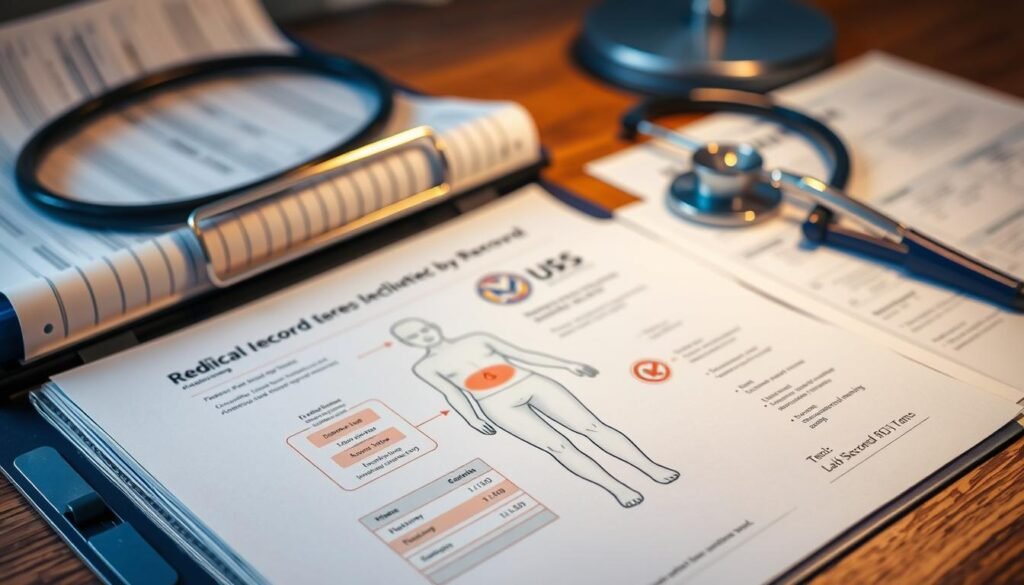Are you dealing with loose skin after losing weight or having a baby? You’re not alone. Many people face this issue. But can your insurance help cover the cost of removing this skin? The answer might be yes.
Dr. Alizadeh is an expert in plastic surgery. She knows about the surgery options and how insurance works. Getting insurance for skin removal depends on many things. These include if it’s medically needed, your insurance details, and if you get pre-authorization. We’ll help you understand how to get your insurance to cover your skin removal surgery.
Key Takeaways
- Insurance for removing loose skin looks at medical need, your insurance, and getting pre-authorization.
- There are surgeries for loose skin like Tummy Tuck and Arm Lift.
- Health issues, discomfort, and how it affects you can make insurance more likely to cover it.
- Good medical records, photos, and seeing specialists can help prove you need insurance coverage.
- Knowing your insurance, what you need for pre-authorization, and how to talk to insurers can help you get coverage.
Understanding the Role of Medical Necessity
When thinking about skin removal surgery, knowing about medical necessity is key. Insurance needs to see a procedure as medically necessary before they pay for it. This means the loose skin must be a real health risk or really affect the patient’s life.
Chronic Skin Conditions
Having too much skin can cause ongoing skin problems like infections, rashes, or ulcers. These issues make you feel bad and can hurt your health. If your loose skin leads to these problems, it might be seen as needing insurance coverage.
Physical Discomfort and Limitations
Loose skin can also make everyday tasks hard. For example, it might stop you from working out, cleaning yourself, or finding clothes that fit right. Insurance might see these issues as reasons to cover the surgery.
Psychological Impact
Don’t forget about how loose skin affects your mind. It can lead to feeling sad, anxious, or not good about yourself. If it really gets in the way of your life, insurance might see it as a reason to cover the surgery.
Knowing what insurance looks for in medical necessity helps you ask for coverage for your surgery. Show how your loose skin affects you physically, medically, and mentally. This will help you get the insurance you need.

Documenting Your Case for Coverage
When you want insurance for skin removal, you need to document well. Work with your healthcare provider to show why the surgery is needed. You’ll need to gather medical records, photos, and get advice from specialists.
Detailed Medical Records
First, collect your full medical history. Include records of any skin conditions, pain, or problems caused by extra skin. Make sure to list any treatments you’ve tried to help.
Photographic Evidence
Photos can make your case stronger. Get your healthcare provider to take clear, high-quality pictures. These show how your condition affects you and why the surgery is needed.
Specialist Consultations and Treatments
Talking to specialists like dermatologists or physical therapists helps prove you need the surgery. Their reports can explain why you need it and what treatment you should get. This can really help with insurance.
By documenting your case well, you’re more likely to get insurance for skin removal. Keep trying and work with your healthcare team to make your application strong.

How to get insurance to cover skin removal
Navigating Insurance Policies
Your insurance can affect how much you pay for skin removal. Some policies don’t cover cosmetic treatments. Others have rules you must follow to get coverage. It’s important to know what your policy says about skin removal surgeries.
Pre-authorization Requirements
Many insurers need you to get pre-authorization for skin removal. They look at your health history and condition. They check if the surgery is needed for your health.
This process can be hard, but knowing what they need helps. If your surgery is seen as cosmetic, you might appeal the decision. Or, look into other ways to pay, like medical credit cards or payment plans.
Talking to your insurer and explaining why you need the surgery is key. This can help you get coverage.
| Procedure | Average Cost | Insurance Coverage Considerations |
|---|---|---|
| Panniculectomy | $8,000 – $15,000 | May be covered if excess skin causes medical issues like dermatitis or ulcers, and the excess skin hangs at or below the pubic line. |
| Full-Body Skin Removal | $15,350 | Comprehensive body lift surgery may be considered cosmetic and not covered by insurance. |
Understanding your insurance, going through the pre-authorization, and showing why you need the surgery can help. This way, you might get your insurance to cover your skin removal.
Exploring Skin Removal Procedures
After losing a lot of weight or aging, many people have loose, extra skin. This can be hard on both the body and mind. Luckily, there are surgeries to help. These include the tummy tuck, body lift, and arm lift.
Tummy Tuck (Abdominoplasty)
A tummy tuck, or abdominoplasty, removes extra skin and fat from the belly. It also tightens the muscles there. It’s great for those who’ve lost a lot of weight or had babies. Insurance might cover it if it’s needed for health reasons, like back pain or stomach problems.
Body Lift (Belt Lipectomy)
For loose skin in the lower body, a body lift might help. It works on the belly, butt, hips, and thighs. It removes extra skin and tissue for a smoother look. People often get this after big weight loss to move better and feel more confident.
Arm Lift (Brachioplasty)
An arm lift, or brachioplasty, takes away extra skin and fat from the arms. It’s good for those who’ve lost a lot of weight or are showing signs of aging. It makes the arms look better and improves the body’s shape.
When thinking about excess skin removal procedures, talk to a skilled plastic surgeon. They can suggest the best plastic surgery options for you. With the right surgery, like a Tummy tuck, body lift, and arm lift, you can look and feel great.

Financing Options for Uncovered Costs
Skin removal surgery can be expensive, especially if your insurance doesn’t cover it all. But, there are ways to make it more affordable. You can look into financing options to cover the costs not paid by insurance.
Medical Credit Cards
Medical credit cards are made for healthcare costs. They have good interest rates and flexible payback plans. This makes them a good choice for paying for skin removal surgery costs.
Personal Loans
Personal loans can also help finance your surgery. They usually have lower interest rates than credit cards. You can use them to pay for the whole surgery or to help with insurance gaps.
Payment Plans and Discounts
Many surgeons offer payment plans or discounts for those who can’t pay all at once. You can talk to your surgeon about these options. They might offer interest-free or low-interest plans to help you pay over time.
It’s important to look at the details of any financing option you choose. Make sure it fits your budget and financial goals. By looking at these options, you can get the surgery you need, even if insurance doesn’t cover it all.
| Financing Option | Pros | Cons |
|---|---|---|
| Medical Credit Cards |
|
|
| Personal Loans |
|
|
| Payment Plans and Discounts |
|
|
“Explore all available financing options to make your skin removal surgery more accessible and affordable.”
Conclusion
Getting rid of loose skin after losing a lot of weight is tough. But, knowing your options is important for what you want. Working with experts like Dr. Alizadeh helps you understand insurance and find the best skin removal procedures for you.
Getting to a healthier, more confident you doesn’t have to be hard. With the right help and support, you can deal with the skin and emotional effects of losing weight. We suggest talking to Dr. Alizadeh’s team for a private meeting to move forward in your journey to a new you.
Your health is our main concern. Together, we can make a plan that fits your needs and gets you the results you want. Start moving towards a brighter, more confident future by contacting us now.
FAQ
How can I get my insurance to cover skin removal surgery?
Getting insurance to cover skin removal surgery depends on many things. These include if it’s medically needed, having good documentation, the insurance policy, and getting pre-authorization.
What criteria does insurance consider for medical necessity?
Insurance looks for medical need. This means the loose skin must be a health risk. It should cause skin problems, make daily life hard, or affect the patient’s mental health.
What kind of documentation is needed to support a claim for medical necessity?
You’ll need detailed medical records and photos from a doctor. Also, explain how the loose skin affects your health. Getting advice from specialists and treatments can also help your case.
How do different insurance policies affect coverage for skin removal procedures?
Your insurance policy can change how much you pay. Some don’t cover cosmetic treatments. Others have rules you must follow. You might need to get pre-authorization, which means your medical history and condition will be reviewed.
What are the common surgical options for addressing excess skin?
There are surgeries for loose skin like tummy tucks, body lifts, and arm lifts. The best one depends on what you need and what you’re worried about.
What financing options are available if insurance doesn’t cover the full cost?
If insurance doesn’t pay for everything, you have other ways to pay. You can use medical credit cards, personal loans, or payment plans from the surgery.
